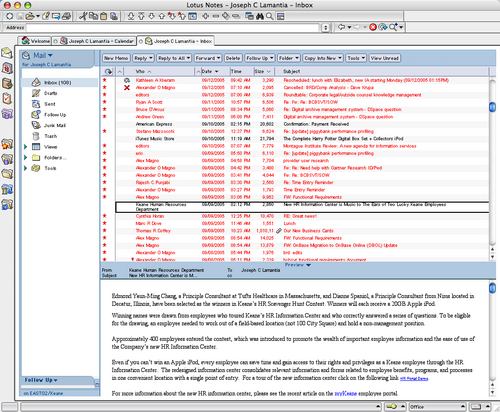Better UI Tops Notes Users’ Wish List
But not the new features list for the next release. In a previous post Lotus Notes UI = Disease, I cited a SearchDomino.com article in which Ken Bisconti, IBM Lotus vice president of Workplace, portal and collaboration products, is quoted as saying “Through improvements such as contextual collaboration and support for composite apps, we’ve gone *above and beyond simple UI enhancement*”. [Emphasis mine.] Above and beyond? I think UI enhancement – which is often far from simple, especially when the existing user experience is fundamentally flawed – is exactly what Notes needs.
After watching software development first hand, I know that many Product Managers understand the importance of quality, design, and meeting users’ needs, but do not feel empowered to work against the pervasive featuritis that leads to unusable bloatware. Good product managers and designers often work for organizations or managers who remain blinded by standard practices and marketing driven perceptions of priority, and thus feel it’s impossible to step off the new functionality treadmill.
That is, unless they are armed with information that indicates to the contrary.
The article in Ken’s statement appears, Beyond Notes 7.0: IBM Lotus sketches ‘Hannover’ user experience, is dated June 14, 2005. Yet when digging it bit more, I discovered an earlier piece from May 9, 2005, titled Better UI tops Notes users’ wish list, in which the same author, Peter Blochner, reports on the results of an open request for Lotus Notes features made by Ed Brill(Brill heads the worldwide sales group for Notes, according to Blochner). In his review of user responses to Brill’s question, Blochner says, “the most requested feature was for an improved user interface for Notes.”
Simple UI enhancement is all that the users want, and they’ve said it themselves. Yet Notes is going way beyond this? Despite repeated and public requests for this from committed users (Ed Brill’s blog is a predominantly Notes-friendly forum) in their own voices, and in response to questions from your own team. Why not listen to them?
For reference, Blochner’s article is reproduced below:
By Peter Bochner
09 May 2005 | SearchDomino.com
IBM is already working on plans for the next major releases of Lotus Notes beyond 7.0. Last week, on May 3, visitors to the blog site of Ed Brill, who heads up worldwide sales for Lotus Notes and Domino, were asked, “If you could add one feature to Lotus Notes 7.x, what would it be?”
As of May 9, his question has garnered 184 comments, although many respondents circumvented the question’s one-feature limit by submitting multiple posts.
To kick off the thread, Brill provided his own request – multi-level undo – and that was reiterated by seven posters. However, the most requested feature was for an improved user interface for Notes. “It’s time to give the Notes client UI a much-needed facelift,” wrote one respondent. When people say Exchange is better than Notes, said another, “What they are saying is that the Outlook interface is . . .nicer than the [Notes] mail template. A top UI for the next release would top off a lot of end-user complaints.”
Only a handful of responses mentioned specific suggestions for improving the UI. One asked for “a first-class, richly configurable Welcome Panel that resembles a Web portal.” Another suggested UI improvements such as “more user-selectable columns in folders/views, having preferences all in one place, or rules that can act on documents already in the mail file.” Still another requested “a sexy modern mail template with a single UI in Notes and on the Web.”
Finally, one user said, “What would it be worth if every part of the Notes mail experience, which …is the Notes interface for the majority of users, from the toolbars to the icons to interaction and behavior, was consistent, modern, clean and inviting? There is no point in having the superior everything if it’s not appealing to look at.”
P.S. Brill has requested a moratorium on suggestions, because the thread is now so long it has become unwieldy.
Related posts:

